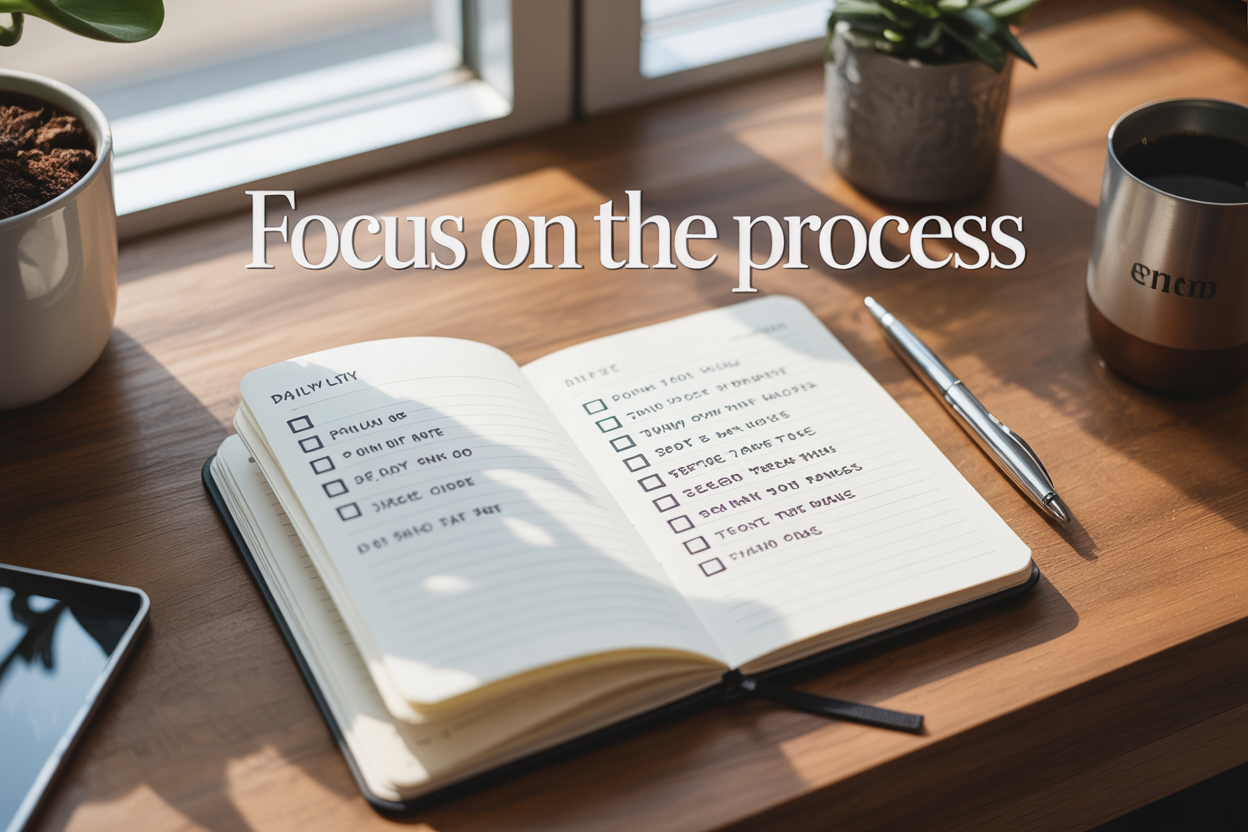Focus on The Process: Achieving Big Goals with Simple, Daily Actions
Big dreams feel overwhelming when you stare at the finish line. That’s why the most successful people don’t obsess over outcomes—they master their daily action system instead. This approach to goal achievement strategies works for entrepreneurs launching startups, fitness enthusiasts transforming their health, students tackling degree programs, and anyone ready to turn ambitious visions into reality.
The secret isn’t motivation or willpower. It’s understanding that small actions big results come from consistent daily habits that compound over time. When you shift from outcome-focused thinking to process vs outcome mindset, everything changes.
We’ll explore why focusing on process beats chasing outcomes and how this mental shift removes pressure while accelerating progress. You’ll discover the science behind small actions creating massive results, including how your brain forms lasting changes through repetition. Finally, we’ll walk through designing your personal daily action system that makes long term goal achievement feel automatic rather than exhausting.
Stop waiting for the perfect moment or magical burst of motivation. Your biggest goals are waiting for you to break them down into daily habits for success that actually stick.
Why Process Beats Outcome in Goal Achievement

The psychology behind outcome-focused failures
When we fixate on end results, our brains trigger stress responses that actually work against us. Research shows that outcome-focused thinking activates the same neural pathways as anxiety, flooding our system with cortisol and making clear decision-making nearly impossible. This happens because big goals feel overwhelming, creating a psychological distance between where we are and where we want to be.
The outcome obsession creates what psychologists call “goal gradient effect” – but in reverse. Instead of speeding up as we approach our target, we often slow down or quit entirely when the finish line seems too far away. Your brain interprets the gap between current reality and desired outcome as a threat, triggering fight-or-flight responses that derail progress.
People who focus solely on outcomes also fall victim to binary thinking. Either they’re succeeding (moving toward the goal) or failing (not there yet). This creates an emotional roller coaster where motivation depends entirely on external validation and visible progress, both of which fluctuate wildly during any meaningful pursuit.
How process-oriented thinking builds sustainable momentum
Process-oriented thinking flips this script entirely. When you focus on daily actions and consistent daily habits, you create what neuroscientists call “intrinsic motivation loops.” Your brain releases dopamine not just from achieving the big goal, but from completing each small action along the way.
This approach builds what researchers term “implementation intentions” – specific if-then scenarios that bypass the willpower bottleneck. Instead of relying on motivation (which fades), you create automatic behavioral responses that compound over time.
The daily action system becomes self-reinforcing. Each completed action strengthens neural pathways, making the next action easier to execute. This creates genuine momentum that doesn’t depend on external circumstances or emotional states. You build confidence through competence, proving to yourself daily that you’re someone who follows through.
Process focus also provides immediate feedback loops. Instead of waiting months or years to know if you’re “succeeding,” you get clear yes/no answers daily: Did I complete my process? This clarity eliminates the uncertainty that kills long-term motivation.
Breaking the all-or-nothing mindset trap
The all-or-nothing mindset is goal achievement’s silent killer. This cognitive trap convinces people that anything less than perfection equals failure, creating unnecessary pressure that makes quitting feel logical.
Process thinking naturally breaks this pattern by celebrating consistency over perfection. Miss one day? No problem – the process continues tomorrow. Have a bad week? The system remains intact. This flexibility prevents the shame spiral that derails most goal-setting attempts.
Smart process design includes what habit formation experts call “minimum viable actions” – versions of your daily habits so small they’re impossible to skip. Can’t do a full workout? Do five push-ups. Can’t write for an hour? Write one sentence. These micro-actions maintain the behavioral chain even during challenging periods.
The beauty lies in how small actions big results thinking reframes “failure.” In outcome-focused approaches, missing targets feels devastating. In process-focused approaches, temporary setbacks become data points for system improvement, not judgments of personal worth.
Real-world examples of process-driven success stories
Jerry Seinfeld’s “don’t break the chain” method perfectly illustrates process mastery. Instead of focusing on becoming a great comedian, he focused on writing jokes daily. His only metric was marking an X on a calendar after writing. This simple daily action system eventually made him one of comedy’s most successful figures.
Maya Angelou wrote every single book using the same process: renting a hotel room, stripping it of all decorations, and writing from 7 AM to 2 PM daily. She didn’t focus on bestseller status or critical acclaim. Her process was showing up, sitting down, and writing. This approach produced some of literature’s most celebrated works.
Modern examples abound in business and athletics. Amazon’s Jeff Bezos built the company on process-oriented thinking: “We don’t wake up in the morning and say ‘Let’s figure out how to make more money.’ We wake up and say ‘Let’s figure out how to serve customers better.'” This daily focus on customer service processes, not profit outcomes, created unprecedented long-term success.
Professional athletes provide perhaps the clearest examples. Tom Brady didn’t focus on winning Super Bowls during daily practice – he focused on perfecting his throwing mechanics, studying film, and maintaining his physical condition. The championships became natural byproducts of consistent process execution.
These achieving big goals examples share common threads: simplified focus, daily consistency, and measuring inputs rather than outputs.
The Science of Small Actions Creating Massive Results

Understanding the compound effect in daily habits
The compound effect works like interest in a savings account, but for your personal development. When you perform small actions repeatedly, they don’t just add up—they multiply. A 5-minute morning routine might seem insignificant today, but after 365 days, you’ve invested over 30 hours in yourself. That’s nearly a full work week dedicated to your growth.
This principle applies to every area of life. Reading 10 pages daily equals 3,650 pages per year—roughly 12 books. Writing 200 words daily produces a full-length novel. The magic happens because each day builds upon the previous one, creating momentum that becomes increasingly powerful over time.
The compound effect explains why some people seem to achieve extraordinary results while others struggle. Those who understand this concept focus relentlessly on consistent daily habits rather than sporadic bursts of effort. They know that missing one day breaks the chain and reduces the exponential growth potential.
Research shows that habits compound not just in quantity but in quality. As you repeat an action, your efficiency improves, your confidence grows, and the behavior becomes automatic. What once required significant willpower eventually happens without conscious thought, freeing up mental energy for more complex challenges.
How your brain responds to consistent micro-behaviors
Your brain treats repeated actions as important survival information, literally rewiring itself to support these patterns. When you perform the same small action consistently, neural pathways strengthen through a process called myelination—essentially wrapping your brain circuits in a protective coating that makes signals travel faster and more efficiently.
This neuroplasticity means your brain becomes increasingly optimized for your daily habits for success. The first few weeks of any new habit feel difficult because your brain hasn’t yet built the neural infrastructure. But around the 21-day mark, something shifts. The pathways become more established, and the behavior starts feeling more natural.
Dopamine plays a crucial role in this process. Your brain releases this “reward” chemical not just when you complete a task, but when you anticipate doing it. Over time, your brain begins associating the habit with pleasure, making you actually crave the behavior. This is why consistent exercisers feel restless on rest days or why regular writers feel compelled to put words on paper.
The basal ganglia, your brain’s habit center, takes over routine behaviors to conserve mental energy. This automation is why you can drive familiar routes while thinking about other things. When your goal achievement strategies become automated habits, pursuing big goals requires less conscious effort and willpower.
The 1% improvement principle that transforms lives
James Clear popularized the 1% principle, but the concept has ancient roots. The idea is simple: improve by just 1% daily, and you’ll be 37 times better by year’s end. This isn’t just mathematical theory—it’s how small actions create big results in real life.
The beauty of 1% improvement lies in its sustainability. Most people can handle tiny adjustments without triggering resistance or burnout. Instead of overhauling your entire routine, you make microscopic changes that compound over time. Wake up 3 minutes earlier. Do one extra push-up. Read one additional page. These micro-improvements feel effortless but create massive long-term transformation.
This principle works because it sidesteps your brain’s change resistance. Large changes trigger fight-or-flight responses, making you want to return to familiar patterns. But 1% adjustments fly under the radar, allowing you to build momentum without internal sabotage.
The reverse is equally powerful—and concerning. A 1% daily decline leads to near-zero results after a year. This explains why people who neglect consistent daily habits gradually drift away from their goals. They don’t fail dramatically; they fade slowly through tiny compromises.
| Improvement Rate | Daily Change | Annual Result |
|---|---|---|
| 1% Better | 1.01^365 | 37.8x Improvement |
| 1% Worse | 0.99^365 | 0.03x (97% Decline) |
| No Change | 1.00^365 | 1.0x (Same Result) |
The key is choosing your 1% improvements strategically, focusing on actions that directly support your biggest goals while remaining small enough to maintain consistently, even on challenging days.
Designing Your Daily Action System for Big Goals

Breaking down overwhelming goals into manageable tasks
Big goals feel impossible when you stare at them as a single massive mountain to climb. The secret lies in breaking them into daily actions small enough that skipping them feels ridiculous. Take writing a book – instead of “write 300 pages,” think “write 250 words daily.” That’s roughly one paragraph, achievable even on your worst day.
Start with your end goal and work backward. If you want to lose 50 pounds in a year, that’s roughly one pound per week. Break that down to a daily calorie deficit of 500 calories through diet and exercise. Suddenly, your overwhelming goal becomes “eat 300 fewer calories and walk 30 minutes today.”
The key is making each task so specific and small that your brain can’t find excuses. “Get in shape” becomes “do 10 push-ups after breakfast.” “Learn Spanish” becomes “practice 5 new vocabulary words during lunch break.” When tasks feel manageable, you build momentum instead of overwhelm.
Creating non-negotiable daily minimums
Your daily action system needs a foundation that survives your worst days. These are your non-negotiable minimums – the bare minimum actions you commit to doing regardless of circumstances. Think of them as your goal achievement insurance policy.
Set minimums so low they’re almost embarrassing not to do. If your goal is reading 50 books this year, your minimum might be reading just two pages daily. On good days, you’ll naturally read more. On terrible days, those two pages keep your streak alive and maintain the habit pathway in your brain.
Your minimums should take no more than 10-15 minutes total. This isn’t about perfectionism – it’s about consistency. A two-minute meditation beats skipping meditation entirely. Five minutes of writing beats waiting for the perfect two-hour writing session that never comes.
Building habit stacks for maximum efficiency
Habit stacking links new behaviors to existing routines, making your daily action system feel natural rather than forced. Your brain already has established neural pathways for existing habits – you’re just adding new stops to routes you already travel.
Identify strong existing habits first. Maybe you drink coffee every morning, check your phone after lunch, or brush your teeth before bed. These become anchors for new behaviors. “After I pour my morning coffee, I’ll write three gratitude items.” “After I check my phone at lunch, I’ll review my language flashcards.”
Stack habits in logical sequences that flow naturally. If your goal involves fitness and learning, you might create: “After I finish my workout, I’ll listen to one educational podcast episode while stretching.” This maximizes efficiency while the endorphins from exercise enhance learning.
Time-blocking strategies that actually work
Generic time-blocking advice fails because it ignores energy levels and real-world interruptions. Effective time-blocking matches your most important daily actions to your peak energy periods and builds in realistic buffers.
Map your energy patterns first. Most people have 2-3 high-energy windows daily – often early morning, late morning, and sometimes late afternoon. Schedule your most challenging goal-related tasks during these peaks. Save low-energy tasks like checking emails or organizing for your natural dips.
Block time in 25-90 minute chunks based on the task. Deep work like writing or strategic planning needs longer blocks. Quick habit actions like exercise or skill practice work well in shorter windows. Always add 25% buffer time – if you think something takes 40 minutes, block an hour.
Create themed time blocks rather than task-switching constantly. “Morning creation block” for writing, “Afternoon learning block” for skill development, “Evening reflection block” for planning tomorrow. This reduces mental switching costs and creates natural rhythms.
The power of tracking your daily progress
Progress tracking transforms invisible daily actions into visible momentum. Your brain needs evidence that your daily action system is working, especially during the inevitable plateaus where results aren’t obvious yet.
Track inputs, not just outcomes. Instead of only tracking weight loss, track daily walks completed, vegetables eaten, and workouts finished. These input metrics are within your complete control and provide daily wins that fuel motivation.
Use simple tracking methods that take under 30 seconds. A basic notebook, phone app, or wall calendar with checkmarks works better than complex systems you’ll abandon. The goal is creating a visual chain of success that you don’t want to break.
Review your tracking data weekly to identify patterns. Which days consistently challenge you? What environmental factors support or sabotage your daily actions? This data becomes your roadmap for system improvements rather than just a scoreboard.
Overcoming Mental Barriers That Derail Progress

Conquering Perfectionism and the Need for Immediate Results
Perfectionism kills more dreams than failure ever will. When you’re building a daily action system for achieving big goals, the perfectionist mindset becomes your worst enemy. You’ll find yourself waiting for the “perfect” moment to start, or scrapping entire weeks of progress because you missed one day.
The antidote? Embrace the “good enough” approach. Your goal setting process doesn’t need to be flawless from day one. Start messy, adjust as you go, and celebrate small wins along the way. Remember that consistency beats perfection every single time.
The need for immediate results is equally destructive. We live in an instant gratification world, but meaningful achievements take time. When you don’t see dramatic changes after a week of daily habits for success, your brain starts questioning the entire approach. This is where most people abandon ship.
Combat this by shifting your focus from outcomes to inputs. Instead of asking “Am I seeing results yet?” ask “Did I show up today?” Track your daily actions rather than obsessing over end results. Create a simple checklist that measures effort, not achievement. This mental shift transforms your entire relationship with progress.
Set micro-milestones within your larger journey. If your big goal takes six months, celebrate monthly progress markers. These smaller celebrations keep your motivation tank full while teaching your brain to value the process over instant gratification.
Dealing with Motivation Dips and Consistency Challenges
Motivation is overrated. Relying on motivation alone is like trying to drive cross-country with half a tank of gas – you won’t make it very far. The most successful people understand that motivation comes and goes, but systems stay.
Build your daily action system around structure, not feelings. Create specific triggers that automatically initiate your actions regardless of how you feel. Maybe it’s putting on your workout clothes immediately after your morning coffee, or opening your laptop to write as soon as you finish breakfast. These environmental cues remove the decision-making burden from your tired brain.
Consistency challenges often stem from setting the bar too high. When life gets busy or stressful, your ambitious daily habits become the first casualties. The solution? Create scaling options for different life scenarios. Have a “perfect day” version, a “busy day” version, and a “survival mode” version of your routine.
For example, if your goal involves writing, your perfect day might include 2000 words, your busy day could be 500 words, and survival mode might just be opening the document and writing one sentence. This flexibility prevents all-or-nothing thinking that destroys long-term momentum.
Track your consistency visually. Use a simple calendar where you mark off each day you complete your core actions. This visual progress creates its own motivational loop and helps you spot patterns in your behavior.
Managing Setbacks Without Losing Momentum
Setbacks aren’t roadblocks – they’re speed bumps. The difference lies in how you handle them mentally and practically. When you miss a day, skip a workout, or fall behind on your goal achievement strategies, your next decision determines everything.
The biggest mistake people make after a setback is catastrophic thinking. One missed day becomes “I’ve ruined everything” and suddenly you’re starting over from scratch. This black-and-white mindset transforms minor hiccups into major derailments.
Instead, treat setbacks like bad weather – temporary conditions that require slight adjustments, not complete route changes. Get back to your routine immediately, without drama or self-punishment. The faster you return to your process, the less impact the setback has on your overall progress.
Create a “comeback protocol” before you need it. Decide in advance what you’ll do when (not if) you face obstacles. Maybe it’s reaching out to an accountability partner, reviewing your why, or simply doing a scaled-down version of your normal routine. Having a predetermined response removes the emotional decision-making that often leads to extended breaks.
Document your setbacks and recovery strategies. This creates a personal database of what works when challenges arise. Over time, you’ll notice patterns and develop increasingly effective ways to bounce back quickly.
Turning Failures into Learning Opportunities
Reframe failure as data collection. Every time something doesn’t go according to plan, you’re gathering valuable information about what works, what doesn’t, and how to improve your approach. This mindset shift transforms frustrating experiences into stepping stones toward success.
Conduct regular “failure audits” without judgment. Ask yourself: What specific circumstances led to this outcome? What could I have done differently? What worked well despite the overall failure? This analytical approach removes the emotional sting and focuses your attention on actionable insights.
Small actions big results philosophy applies to learning from failures too. Don’t try to overhaul your entire system after one setback. Make tiny adjustments based on what you learned. Maybe you need to move your workout time, adjust your environment, or modify your expectations. Small tweaks compound into significant improvements over time.
Create a “lessons learned” journal where you document insights from both successes and failures. Review this periodically to spot recurring themes and blind spots. This practice transforms individual failures into collective wisdom that guides better decisions moving forward.
Remember that failure is feedback, not a verdict. Each setback provides information about your current approach while offering opportunities to strengthen your process. The goal isn’t to avoid failure completely – it’s to fail faster, learn quicker, and adjust your daily habits for success accordingly.
Sustaining Long-Term Success Through Process Mastery

Creating accountability systems that keep you on track
Building a reliable accountability system acts as your safety net when motivation fades. The most effective systems combine both personal and external accountability measures that create gentle pressure to stay consistent with your daily habits for success.
Start by tracking your daily actions in a visible way. A simple habit tracker, whether digital or paper-based, gives you immediate feedback on your consistency. This visual representation of your progress creates a psychological pull to maintain your streak and avoid breaking the chain of daily actions.
Partner accountability takes this further by involving another person in your journey. Share your specific daily actions with a trusted friend, family member, or colleague who will check in with you regularly. The key is choosing someone who will ask tough questions without judgment. Weekly check-ins work better than daily ones, as they allow time for patterns to emerge while maintaining regular touchpoints.
Consider joining or creating a community around your goals. Online groups, local meetups, or mastermind circles provide collective accountability where everyone supports each other’s long term goal achievement. The social aspect makes the process more enjoyable while creating multiple accountability relationships.
Public commitment adds another layer by making your intentions visible to a broader audience. Sharing your goals and progress on social media or with your professional network creates reputational stakes that motivate consistency. The fear of public failure often drives action when personal motivation wavers.
Celebrating small wins to maintain motivation
Recognizing progress in small increments prevents the motivational dips that derail most people from achieving big goals. Your brain needs regular doses of accomplishment to maintain the dopamine pathways that drive consistent action.
Design celebration rituals for your daily wins. This doesn’t mean throwing a party every time you complete a task. Instead, create meaningful micro-celebrations that acknowledge your effort. After completing your daily writing goal, enjoy a special cup of coffee. After finishing your workout, take a moment to appreciate how your body feels. These small rewards reinforce the positive associations with your goal achievement strategies.
Weekly and monthly milestone celebrations deserve more substantial recognition. Plan activities that align with your values and feel genuinely rewarding. If you’ve maintained your daily reading habit for a month, treat yourself to a new book or visit a bookstore you love. The celebration should connect to the process you’re building rather than undermining it.
Track metrics that highlight progress beyond the final outcome. Document how you feel after completing daily actions, note improvements in your skills or knowledge, and measure secondary benefits like increased energy or better sleep. This broader view of progress provides more opportunities for celebration and motivation.
Share your wins with others. Your accountability partners want to hear about your successes, no matter how small they seem to you. Celebrating together reinforces the positive aspects of your process and builds stronger support relationships.
Adjusting your process as you evolve and grow
Your daily action system needs flexibility to remain effective as your circumstances, skills, and understanding evolve. What works at the beginning may become inefficient or irrelevant as you progress toward your bigger goals.
Schedule regular process reviews to evaluate what’s working and what isn’t. Monthly assessments work well for most people, providing enough data to identify patterns without making changes too frequently. During these reviews, ask yourself: Which actions feel effortless now? Where are you still struggling? What new challenges have emerged?
Upgrade your processes based on increased capacity. As actions become habitual, you can often increase intensity, duration, or complexity without additional mental effort. A writer who started with 200 words daily might naturally progress to 500 words as the writing habit solidifies. The key is making changes gradually to avoid overwhelming your system.
Adapt to life changes proactively. New jobs, relationships, living situations, or health challenges require process adjustments. Instead of abandoning your system entirely, modify it to fit new circumstances. A parent returning to work might shift their workout from morning to lunch break rather than stopping exercise altogether.
Learn from setbacks by analyzing what caused them. Most disruptions stem from rigid processes that couldn’t bend under pressure. Build flexibility into your system by having backup plans for common obstacles. If your usual morning routine gets disrupted, know exactly how you’ll maintain your core habits later in the day.
Building a lifestyle around continuous improvement
Transform your goal achievement strategies into a permanent way of living rather than a temporary phase of effort. This shift from project-based thinking to lifestyle-based thinking ensures sustainable progress over decades.
Develop identity-based habits that align with who you want to become. Instead of saying “I want to lose weight,” think “I am someone who takes care of my body.” This identity shift makes daily actions feel natural rather than forced. Each small action reinforces your evolving identity, creating a positive feedback loop that strengthens over time.
Create environmental design that supports your process automatically. Arrange your physical and digital spaces to make good choices easier and bad choices harder. Keep workout clothes visible, place books where you relax, and remove distractions from your work area. Your environment should guide you toward desired behaviors without requiring willpower.
Embrace the compound nature of consistent daily habits. Small improvements compound exponentially over time, creating results that seem impossible from today’s perspective. A person who reads 20 pages daily will complete 50+ books per year, transforming their knowledge base. Someone who exercises 30 minutes daily builds strength and health that pays dividends for decades.
Integrate learning and adjustment as core components of your lifestyle. Continuous improvement means constantly seeking better ways to achieve your goals. Read about your field, experiment with new techniques, and study successful people in areas you want to develop. This learning mindset keeps your processes fresh and prevents stagnation.
Make process mastery your meta-skill. The ability to design, implement, and refine systems for achieving any goal becomes more valuable than achieving any single goal. Once you master the art of building effective processes, you can tackle increasingly ambitious objectives throughout your life.

Big goals don’t happen overnight, but they do happen one day at a time. When you shift your focus from the distant finish line to the simple actions you can take today, everything changes. Small daily habits compound into remarkable results, and the science backs this up. Your brain actually rewires itself through consistent practice, making progress feel more natural and automatic over time.
The magic lies in building a system that works for your life and sticking to it, even when motivation fades. Those mental roadblocks that pop up? They’re normal, and they’re beatable when you have the right strategies. Start with one small action today that moves you toward your big goal. Make it so easy you can’t say no, then show up tomorrow and do it again. Your future self will thank you for choosing process over perfection.









